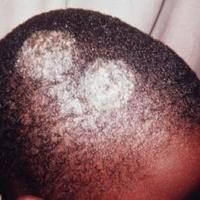Infection
Fighting skin fungus
An itchy, scaly rash can be unsightly and drive you crazy. But most fungal infections aren’t dangerous, and you can usually treat them easily with creams. If you tend to get repeated fungal infections, talk to your healthcare provider about how to prevent rashes from returning.
Ringworm is one of the most common skin infections that is caused by a fungus. It is contagious and extremely common. It can affect 20 to 25 per cent of the world’s population at any given time. It’s called “ringworm” because it can cause a circular rash (shaped like a ring) that is usually red and itchy. Anyone can get ringworm. The fungi that cause this infection can live on skin, surfaces, and on household items such as clothing, towels, and bedding.
Ringworm typically begins as a flat, discoloured patch, which may appear red in lighter complexions and brown in darker complexions. The patch has a ring-like or circular shape with a raised, scaly border.
It affects people of all ages. You’re more at risk for ringworm if you have a weakened immune system or an autoimmune disease like lupus; participate in high-contact sports, such as wrestling (this ringworm is called tinea gladiatorum); sweat excessively (hyperhidrosis); use public locker rooms or public showers or work closely with animals that might have ringworm.
Ringworm goes by many names. The medical terms are “tinea” or “dermatophytosis.” Other names for ringworm are based on its location on the body – for example, ringworm on the feet is also called “athlete’s foot”.
Ringworm is an itchy, contagious fungal infection that causes a ring-shaped pattern on your skin. Over-the-counter and prescription treatments can stop the fungus from spreading to other parts of your body or to others.
Fungi thrive in warm and humid areas such as locker rooms and public showers. This common and contagious skin infection gets its name from the red, itchy, ring-shaped skin plaque (a type of scaly rash). It spreads easily and through close contact.
You get ringworm from contact with an infected person, animal or object. Ringworm goes by different names depending on which body part it affects. Ringworm on your body is called tinea corporis. This type of ringworm affects your arms, legs, torso and face. Ringworm is treated with antifungal medication available either over the counter or as a prescription.
Types of ringworm
Ringworm has different names based on where it appears on your body — and it can appear just about anywhere. Ringworm infections include:
Athlete’s foot: Also called tinea pedis, this fungal infection causes an itchy, burning skin rash between your toes and on the soles of your feet. Your skin may become scaly and cracked or develop blisters. Sometimes, your feet smell bad.
Jock itch: Tinea cruris, or jock itch, causes a red, itchy rash in your groin, upper thighs or rectum. Some people get blisters.
Scalp ringworm (tinea capitis): This causes scaly, red, itchy bald spots on your scalp. If left untreated, the bald spots can grow bigger and become permanent.
Hands (tinea manuum): Signs of ringworm on your hands include dry, cracked palms and ring-like patches.
Beard (tinea barbae): Ringworm appears on your neck, chin and cheeks. The patches might become crusted over or filled with pus.
Toenails or fingernails (tinea unguium or onychomycosis): Nails become thick, discoloured and deformed.
Symptoms and Causes
What are the signs of
ringworm?
Signs typically appear between four and 14 days after your skin comes in contact with the fungi that cause ringworm, including:
• Circular, ring-shaped scales or plaques.
• Flat patches with a raised, round border.
• Itchy skin.
• Hair loss or bald spots in the affected area.
What causes ringworm?
Despite its name, a fungus causes ringworm. This type of fungus naturally lives on your skin, hair and nails. However, when their environment gets hot and damp, the fungi start growing uncontrollably. You can get this infection anytime your skin comes into contact with the ringworm fungus on someone else’s skin.
How contagious is
ringworm?
Ringworm is contagious. It can live on your skin, on surfaces and in soil. The main ways ringworm spreads are:
• Skin-to-skin contact with a person who has ringworm.
• Contact with an infected dog, cat or animal (livestock or pets).
• Contact with a contaminated surface, such as a locker room floor or sweaty gym clothes.
• Sharing objects with an infected person or animal such as a brush, towel or bedding.
• Contaminated soil.
• Diagnosis and Tests
How is ringworm
diagnosed?
Your healthcare provider can diagnose ringworm by looking at your skin and assessing your symptoms. They may scrape the area to look at the skin cells under a microscope, too. Examining the scales typically confirms ringworm.
Management and Treatment
How is ringworm treated?
Several non-prescription (over-the-counter) and prescription antifungal medications are available to treat ringworm. Antifungals come in various forms like creams, gels or powders. Your healthcare provider can treat more widespread ringworm with oral antifungal medication.
Antifungal creams and powders
Over-the-counter (OTC) antifungal creams, gels or powders typically work well.

